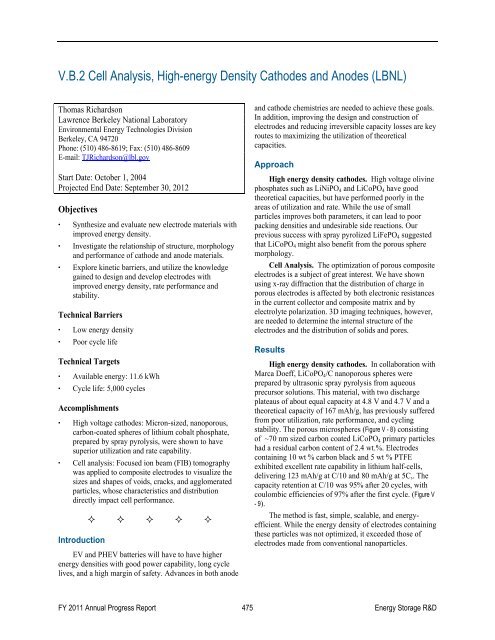V. Focused Fundamental Research - EERE - U.S. Department of ...
V. Focused Fundamental Research - EERE - U.S. Department of ...
V. Focused Fundamental Research - EERE - U.S. Department of ...
Create successful ePaper yourself
Turn your PDF publications into a flip-book with our unique Google optimized e-Paper software.
V.B.2 Cell Analysis, High-energy Density Cathodes and Anodes (LBNL)<br />
Thomas Richardson<br />
Lawrence Berkeley National Laboratory<br />
Environmental Energy Technologies Division<br />
Berkeley, CA 94720<br />
Phone: (510) 486-8619; Fax: (510) 486-8609<br />
E-mail: TJRichardson@lbl.gov<br />
Start Date: October 1, 2004<br />
Projected End Date: September 30, 2012<br />
Objectives<br />
· Synthesize and evaluate new electrode materials with<br />
improved energy density.<br />
· Investigate the relationship <strong>of</strong> structure, morphology<br />
and performance <strong>of</strong> cathode and anode materials.<br />
· Explore kinetic barriers, and utilize the knowledge<br />
gained to design and develop electrodes with<br />
improved energy density, rate performance and<br />
stability.<br />
Technical Barriers<br />
· Low energy density<br />
· Poor cycle life<br />
Technical Targets<br />
· Available energy: 11.6 kWh<br />
· Cycle life: 5,000 cycles<br />
Accomplishments<br />
· High voltage cathodes: Micron-sized, nanoporous,<br />
carbon-coated spheres <strong>of</strong> lithium cobalt phosphate,<br />
prepared by spray pyrolysis, were shown to have<br />
superior utilization and rate capability.<br />
· Cell analysis: <strong>Focused</strong> ion beam (FIB) tomography<br />
was applied to composite electrodes to visualize the<br />
sizes and shapes <strong>of</strong> voids, cracks, and agglomerated<br />
particles, whose characteristics and distribution<br />
directly impact cell performance.<br />
Introduction<br />
<br />
EV and PHEV batteries will have to have higher<br />
energy densities with good power capability, long cycle<br />
lives, and a high margin <strong>of</strong> safety. Advances in both anode<br />
and cathode chemistries are needed to achieve these goals.<br />
In addition, improving the design and construction <strong>of</strong><br />
electrodes and reducing irreversible capacity losses are key<br />
routes to maximizing the utilization <strong>of</strong> theoretical<br />
capacities.<br />
Approach<br />
High energy density cathodes. High voltage olivine<br />
phosphates such as LiNiPO 4 and LiCoPO 4 have good<br />
theoretical capacities, but have performed poorly in the<br />
areas <strong>of</strong> utilization and rate. While the use <strong>of</strong> small<br />
particles improves both parameters, it can lead to poor<br />
packing densities and undesirable side reactions. Our<br />
previous success with spray pyrolized LiFePO 4 suggested<br />
that LiCoPO 4 might also benefit from the porous sphere<br />
morphology.<br />
Cell Analysis. The optimization <strong>of</strong> porous composite<br />
electrodes is a subject <strong>of</strong> great interest. We have shown<br />
using x-ray diffraction that the distribution <strong>of</strong> charge in<br />
porous electrodes is affected by both electronic resistances<br />
in the current collector and composite matrix and by<br />
electrolyte polarization. 3D imaging techniques, however,<br />
are needed to determine the internal structure <strong>of</strong> the<br />
electrodes and the distribution <strong>of</strong> solids and pores.<br />
Results<br />
High energy density cathodes. In collaboration with<br />
Marca Doeff, LiCoPO 4 /C nanoporous spheres were<br />
prepared by ultrasonic spray pyrolysis from aqueous<br />
precursor solutions. This material, with two discharge<br />
plateaus <strong>of</strong> about equal capacity at 4.8 V and 4.7 V and a<br />
theoretical capacity <strong>of</strong> 167 mAh/g, has previously suffered<br />
from poor utilization, rate performance, and cycling<br />
stability. The porous microspheres (Figure V - 8) consisting<br />
<strong>of</strong> ~70 nm sized carbon coated LiCoPO 4 primary particles<br />
had a residual carbon content <strong>of</strong> 2.4 wt.%. Electrodes<br />
containing 10 wt % carbon black and 5 wt % PTFE<br />
exhibited excellent rate capability in lithium half-cells,<br />
delivering 123 mAh/g at C/10 and 80 mAh/g at 5C,. The<br />
capacity retention at C/10 was 95% after 20 cycles, with<br />
coulombic efficiencies <strong>of</strong> 97% after the first cycle. (Figure V<br />
- 9).<br />
The method is fast, simple, scalable, and energyefficient.<br />
While the energy density <strong>of</strong> electrodes containing<br />
these particles was not optimized, it exceeded those <strong>of</strong><br />
electrodes made from conventional nanoparticles.<br />
FY 2011 Annual Progress Report 475 Energy Storage R&D



